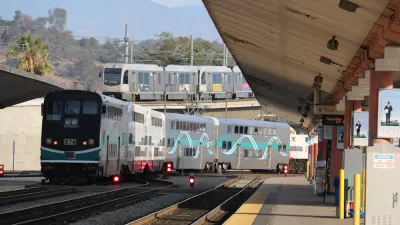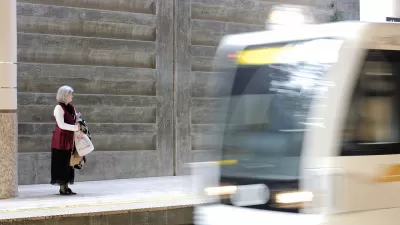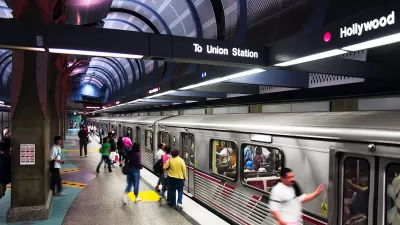Los Angeles Metro's new Gold Line light rail extension is attracting riders from the regional Metrolink commuter rail line that serves San Bernardino. The editorial board of the Daily Bulletin suggests that's not necessarily a problem.
Transit redundancy is a good thing, especially when one mode is unable to operate, be it by labor strike, mechanical breakdown, derailment or natural disaster. More commonly, the more options a commuter has to driving, the better it is for reducing congestion and improving the environment.
But as Planetizen editor James Brasuell posted July 31, the competition between two rail modes in Southern California appears like transit cannibalization.
"There’s a bit of friction between Metrolink and L.A. Metro as the latter’s rails reach toward the Inland Empire," observes the Inland Valley Daily Bulletin editorial board. "But we’re confident they can work it out and manage to serve complementary, sometimes overlapping constituencies of passengers."
The opening in March last year of the 6-station, 11.5-mile, first phase of Los Angeles Metro's Gold Line Foothill (light rail) Extension to Azusa in the San Gabriel Valley has unexpectedly resulted in attracting riders from Metrolink's San Bernardino commuter rail line (see schedule). Thousands have switched to the more frequent [see schedule (pdf)] light rail train costing only $1.75 for an adult ride, regardless of trip length.
"And that trend figures to grow as the 12.3-mile, six-station Foothill Gold Line light rail extension from Azusa to Claremont and then Montclair," adds the editorial. The opening of the extension has been delayed two years and is expected to open by December 2025 or early 2026,
Between January and March, Metrolink lost 25 percent of its boardings at its [station in Covina, Los Angeles County], which is just four miles from the popular Gold Line’s Azusa Pacific/Citrus College station that opened March 5.
The editorial board opines that "[c]onnectivity of transportation systems — rail or otherwise — is always a good thing...[s]o there should be no going back on plans for the two rail lines to meet up in Pomona, Claremont and Montclair." They point to Metrolink's advantages – "It’s faster, with fewer stops, more comfortable and has tables where riders can work or play" to distinguish the two rail modes.
Less-frequent, more expensive, but faster and more comfortable commuter rail competes with heavy rail in many of the nation's larger cities, such as Planetizen reader SuperChief49 observed in the relationship between Metra and Chicago Transit Authority or in Queens by the MTA subway and MTA's Long Island Rail Road.
Light rail and commuter rail competition should be no different. As the editorial concludes, L.A. Metro and Metrolink "should collaborate to plan for their lines to be efficient and complementary. Freeway congestion likely won’t ease any by the time the Gold Line arrives in Montclair years from now — so there will be enough riders to support both options."
Just the same, Metrolink should try to give its customers more reasons to keep riding their more expensive and far less-frequent trains. For example, the Bay Area's Caltrain commuter line saw ridership after so-called baby bullet service was launched in 2004, though the comparison is tenuous in that Caltrain's transit competition is mainly local bus service.
FULL STORY: Connectivity is key for transportation

Study: Maui’s Plan to Convert Vacation Rentals to Long-Term Housing Could Cause Nearly $1 Billion Economic Loss
The plan would reduce visitor accommodation by 25,% resulting in 1,900 jobs lost.

Alabama: Trump Terminates Settlements for Black Communities Harmed By Raw Sewage
Trump deemed the landmark civil rights agreement “illegal DEI and environmental justice policy.”

Why Should We Subsidize Public Transportation?
Many public transit agencies face financial stress due to rising costs, declining fare revenue, and declining subsidies. Transit advocates must provide a strong business case for increasing public transit funding.

Paris Bike Boom Leads to Steep Drop in Air Pollution
The French city’s air quality has improved dramatically in the past 20 years, coinciding with a growth in cycling.

Why Housing Costs More to Build in California Than in Texas
Hard costs like labor and materials combined with ‘soft’ costs such as permitting make building in the San Francisco Bay Area almost three times as costly as in Texas cities.

San Diego County Sees a Rise in Urban Coyotes
San Diego County experiences a rise in urban coyotes, as sightings become prevalent throughout its urban neighbourhoods and surrounding areas.
Urban Design for Planners 1: Software Tools
This six-course series explores essential urban design concepts using open source software and equips planners with the tools they need to participate fully in the urban design process.
Planning for Universal Design
Learn the tools for implementing Universal Design in planning regulations.
Smith Gee Studio
Alamo Area Metropolitan Planning Organization
City of Santa Clarita
Institute for Housing and Urban Development Studies (IHS)
City of Grandview
Harvard GSD Executive Education
Toledo-Lucas County Plan Commissions
Salt Lake City
NYU Wagner Graduate School of Public Service





























